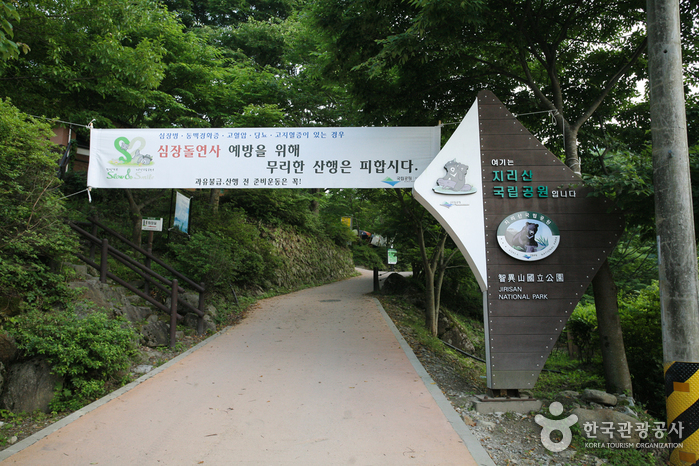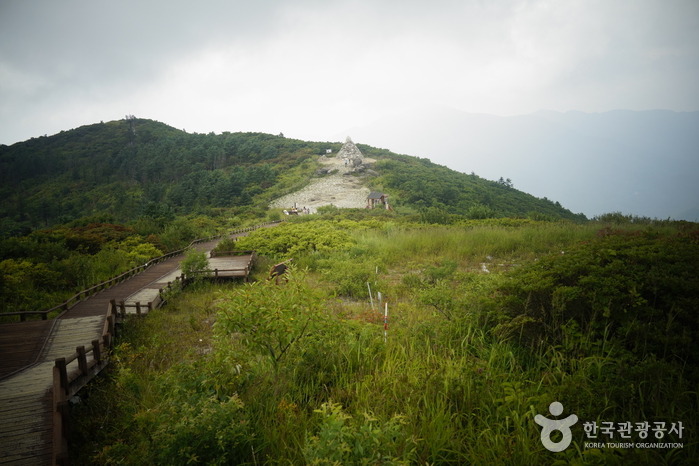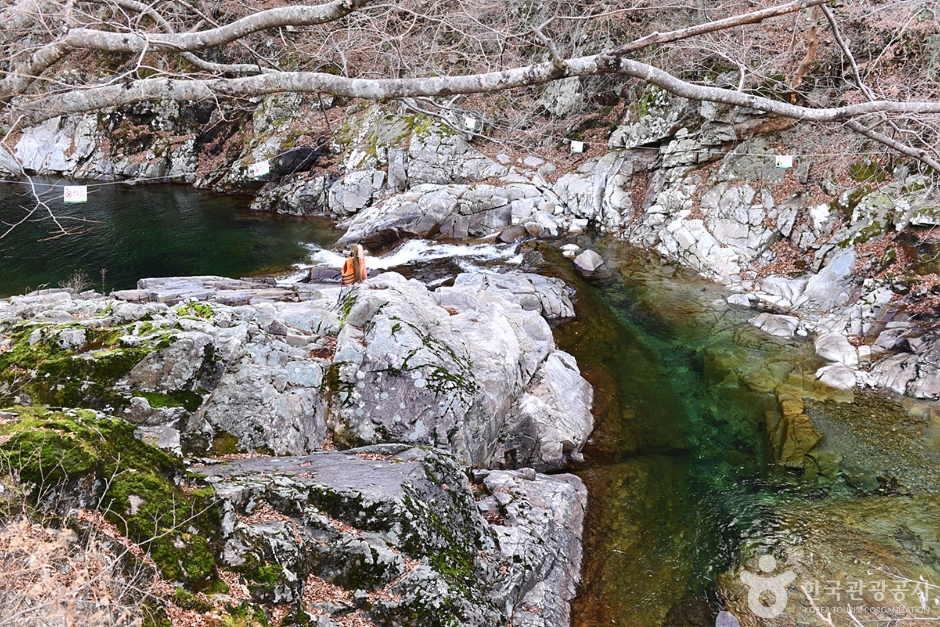Hotel Jirisan Haetsal [Korea Quality] / 지리산햇살 [한국관광 품질인증/Korea Quality]
15.2 Km 61 2021-03-27
386-3, Hwaeomsa-ro, Gurye-gun, Jeollanam-do
+82-61-783-9600
This hotel is located about 300 m away from Jirisan National Park’s Nambu Visitor Center. Built with red bricks and having an orange roof and grass lawn, the hotel resembles a country home. The hotel is surrounded by Jirisan Mountain to the back, and the Masancheon Stream, a branch of Seomjingang River, flowing through the area offers a great view for the visitors. There are five types of rooms, accommodating 2, 4, and 6 guests. A cleaning service is offered every day. The rooms have white walls and wood floorboards, tastefully furnished in a minimalist style. The wide windows offer a great view of the lawn and the mountains. All rooms other than the 4-person ondol (under-the-floor heating system) room are bedrooms, and the 6-person Special Room comes with a wooden terrace. Visitors can enjoy grilling by the valley. The hotel is located about 10 min by car from Gurye Public Bus Terminal. Hwaeomsa Temple, a temple with a thousand-year history, is located only 2 km away from the hotel, while a 10-min drive brings one to Gurye Fifth-day Market and “Unjoru House, Gurye,” which is the Folk Cultural Heritage No. 8 of Korea.
Jirisan National Park (Hamyang Section) (지리산국립공원(함양))
15.3 Km 22010 2021-02-05
Baengmudong-ro, Hamyang-gun, Gyeongsangnam-do
+82-55-970-1000
Designated as the first national park in Korea on December 29, 1967, Jirisan National Park stretches out over 483.022 square kilometers, making it the largest national park among all 22 national parks. It covers Korea’s three southernmost provinces; Gyeongsangnam-do, Jeollanam-do, and Jeollabuk-do, one city, four counties, and 15 districts of eup and myeon. The area in Gyeongsangnam-do has Ssanggyesa Temple, Daewonsa Temple, Beopgyesa Temple, Chilbulsa Temple, and Chilsangsa Temple as well as valleys, falls, and other tourism resources. In particular, famous tourist spots in Hamyang area are Chilseongyegok Valley and Hansingyegok Valley.
Jirisan National Park (Nogodan Peak Section) (지리산국립공원 (지리산 노고단))
15.4 Km 41718 2021-12-25
356, Hwaeomsa-ro, Gurye-gun, Jeollanam-do
+82-61-780-7700
Jirisan National Park covers a vast amount of land in three provinces, including one city and three counties. The countless mountain peaks both large and small blend harmoniously, giving off a comforting ambiance. The valleys feature streams, waterfalls, and more natural attractions beautiful all year round. The mountain is the starting point for the Seomjingang River, which flows into the southern sea.
The park is home to many plants and animals, including the Asiatic black bear. There are many hiking paths crossing the park; it is recommended to make a plan for the courses in advance, checking the lengths and time required. As Jirisan Mountain changes with the different seasons, hikers can enjoy various aspects of the mountain’s terrain. However, some areas will be closed off for hikers' safety in the case of incliment weather or to prevent forest fires in the dry season.
Baemsagol Jirisan Sikdang (뱀사골 지리산식당)
15.7 Km 7444 2024-04-07
271 Jirisan-ro, Sannae-myeon, Namwon-si, Jeonbuk-do
+82-63-626-8800
Baemsagol Jirisan Sikdang specializes in baeksuk (whole chicken soup) and heukdwaeji gui (grilled black pork). They prepare healthy dishes using wild vegetables and traditional Korean medicinal ingredients collected from Jirisan Mountain. In addition to bibimbap and acorn jelly salad, they also offer dishes like grilled deodeok. Visitors can also enjoy their meals on the outdoor tables set up by Dalgunggyegok Valley.
Dalgunggyegok Valley (달궁계곡)
16.5 Km 47073 2024-04-07
Jirisan-ro, Sannae-myeon, Namwon-si, Jeonbuk-do
Dalgunggyegok Valley is a valley located within the Jirisan National Park. It spans 6 kilometers from Dalgung Village to Simwon Village. Surrounded by dense primeval forests, it showcases the pristine beauty of an untouched valley where human hands have yet to reach. The combination of the valley and cliffs creates stunning scenery. Nearby Dalgung Village also preserves remnants of ancient Mahan palaces.
Gurye Cheoneunsa Temple (천은사(구례))
16.8 Km 14499 2021-10-02
209, Nogodan-ro, Gurye-gun, Jeollanam-do
+82-61-781-4800
Located north of Gurye on Jirisan Mountain, and built during the Unified Silla Period, Cheoneunsa Temple is one of the three great Buddhist temples of Jirisan Mountain. Cheoneunsa Temple is believed to have been built by Monk Deokun and Monk Seru from India in AD 828 during the 3rd year of King Heungdeok. Because it initially laid next to spring water as clean and cold as a morning dew, the temple was also called Gamrosa, meaning Sweet Dew Temple. The spring water was rumored to clean one’s body and soul, leading to crowd of Buddhist monks to visit the temple. During King Chungryeol’s reign, the temple was named the Best Temple in the south.
The temple was burned down during the Imjin War (1592-1598) and then later rebuilt and renamed Cheoneunsa. Legend has it that while the temple was being rebuilt, a large serpent often came out of the spring. When the serpent was finally captured and killed, the spring waters suddenly dried up. Hence the name Cheoneunsa, meaning Disappearance of Spring Water, was given.
Gurye Fifth-Day Market & Gurye Traditional Market (구례5일장 / 구례전통시장(3, 8일))
17.2 Km 16129 2021-01-13
20, 5ilsijangjageun-gil, Gurye-gun, Jeollanam-do
+82-61-780-2358
Gurye is famous for its location near the first national park, Jirisan Mountain, and is home to clean water and spacious fields near Seomjingang River. The main products of this area include a variety of wild herbs, vegetables, sansuyu (cornus fruit) and plums from Jirisan Mountain and Baegunsan Mountain.
Houses with cornus fruit trees are easily found in the district of Sandong-myeon, Gurye-gun and the whole village gets dyed yellow in the spring and red in the fall. The amount of sansuyu from the area accounts for nearly half Korea’s total.
Also, chestnuts are common in Gurye Market as a complex of chestnut tree takes up 1,400 ㏊ of the land.
Saseongam Hermitage (Gurye) (사성암(구례))
17.3 Km 37101 2024-02-19
303 Saseongam-gil, Muncheok-myeon, Gurye-gun, Jeollanam-do
Saseongam Hermitage is a hermitage located at the peak of Osan in Gurye (elevation 531m). It is estimated to have been built during the Baekje period (B.C. 18-A.D. 660). Many people visit it to see the sanctuary where the 53 statues of the Buddhist Avatamsaka Sutra are enshrined. The view of the Seomjingang River and the village from the temple is magnificent, and the refreshing breeze feels as if it penetrates through one's body, leading to its designation as a scenic spot in August 2014.
Yeoneu [Korea Quality]여느[한국관광 품질인증]
17.5 Km 1 2023-05-23
116-68 , Cheonbyeon-gil, Gurye-gun, Jeollanam-do
+82-10-7353-1802
Pension Yeoneu in Gurye, Jeollanam-do, stands on the site where Korean independence activist Wang Jae-il was born. The mint-green roof gives the place a fairy tale feel, while inside it’s friendly and welcoming. The pension is let out as a single house, which includes an annex building with a large bathtub, a sunroom, and a sun deck. Throughout the house, guests will notice vintage items collected from the owner’s travels in the US, Europe and Korea.
Seoamjeongsa Temple (서암정사(함양))
17.5 Km 43110 2024-02-21
27-79 Gwangjeom-gil, Macheon-myeon, Hamyang-gun, Gyeongsangnam-do
Seoamjeongsa Temple belongs to Byeoksongsa Temple, which is at the entrance of the Chilseongyegok Valley of Jirisan Mountain. Monk Woneung rebuilt Byeoksongsa Temple, which had been damaged during the Korean War in 1950. This hermitage features the Buddha statues Woneung carved into the natural bedrock, a grotto sanctuary with statues of the Pure Land, Daebanggwangmun Gate, and Sajagul Cave.
![Hotel Jirisan Haetsal [Korea Quality] / 지리산햇살 [한국관광 품질인증/Korea Quality]](http://tong.visitkorea.or.kr/cms/resource/03/2708603_image2_1.jpg)




![Yeoneu [Korea Quality]여느[한국관광 품질인증]](http://tong.visitkorea.or.kr/cms/resource/34/2949134_image2_1.jpg)
 English
English
 한국어
한국어 日本語
日本語 中文(简体)
中文(简体) Deutsch
Deutsch Français
Français Español
Español Русский
Русский